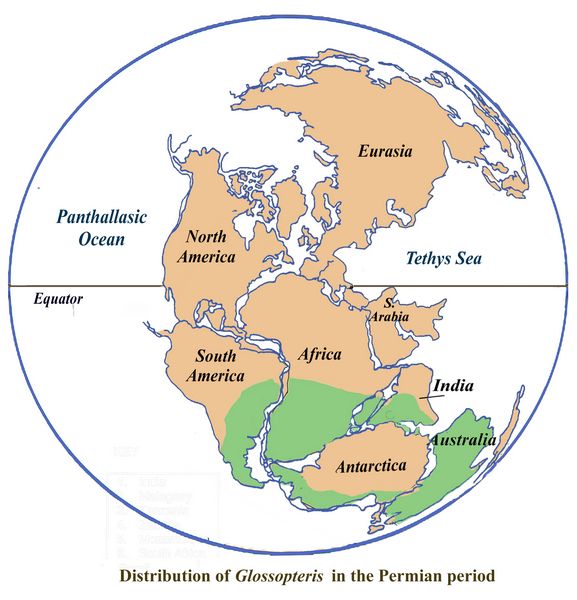Athena Review Image Archive ™
Continental Drift theory

Map of globe, showing Pangaea at the end of the Permian period, ca. 252 mya (Athena Review)
The theory that the continents were slowly moving around on the surface of the Earth was first accurately formulated in 1912 by Alfred Wegener (1880-1930), a German meterologist, polar researcher, and geophysicist. Based on the current outlines of contents such as Africa and South America, Wegerner interpreted that these land masses had moved together by the shifting of continental plates.
Wegener's
theory of Continental Drift (1912, 1929) was not widely accepted for
several decades. Among its most vocal opponents was the American
paleontologist George Gaylord Simpson (1943). The theory began to
gain wide acceptance when paleomagnetic samples from India showed
that the country had previously been in the Southern hemisphere, as
Wegener had predicted. His theory is now fully confirmed and forms the
starting point for current models of plate tectonics.
Evidence
that the continents now detached had once been connected had previously
been seen by Austrian geologist Eduard Suess, who between the 1860s and
1900 studied the distribution of the Permian conifer Glossopteris
on several now detached landmasses in the southern hemisphere. Suess
inferred that these areas, including South America, Africa, India,
Australia, and Antarctica, had once been connected by a land
bridge.
Suess
named the interconnected southern land mass Gondwana after the district
in India where fossils of the plant Glossopteris were abundantly found.
The ancient sea that he postulated to be north of Gondwana he named the
Tethys Sea. Suess's names Gondwana and the Tethys Sea have both been
retained in mapping the various continental formations. The conjunction
of all continents during the Permian and Triassic periods is called
Pangaea, or "whole earth," from Pan- ("whole") and -gaia (the Greek earth goddess).
References:
Suess, Eduard 1885-1901. Das Antlitz der Erde ("The Face of the Earth").
Wegener, Alfred 1912. Die Entstehung der Kontinente (The formation of continents) Geologische Rundschau. Zeitschrift für allgemeine Geologie, dritter Band.
Wegener, Alfred 1929 . Die Entstehung der Kontinente und Ozeane (The Origin of Continents and Oceans) (4th ed.). Braunschweig: Friedrich Vieweg & Sohn Akt.
Copyright © 1996-2020 Rust Family Foundation (All Rights Reserved).